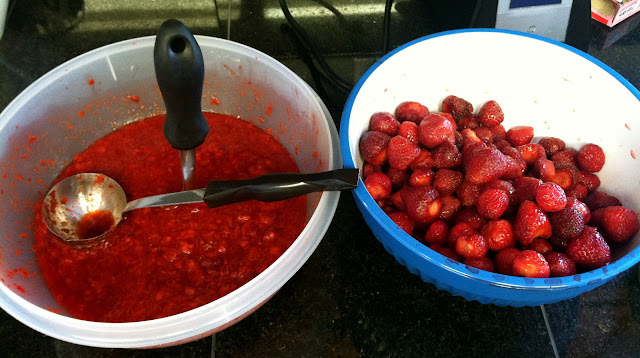Pickles: Step by step photo instructions on how to make homemade pickles
You will need:
Pickling juice: 3 cups water, 3 cups white vinegar, 1/4 cup pickling salt, 1/4 cup sugar
Spices Per jar: 2-3 small garlic cloves, 2 hot peppers, 2-3 heads of dill, 1/2 tablespoon pickling spice
&
Canning supplies
Tip: Wide mouth jars are best for pickles & smaller pickles work best
 |
| 1. Cut off ends of pickles |
 |
| 2. Pickles should look like this after ends are cut off |
 |
| 3. Slice how you would prefer |
 |
| Sandwich style pickles |
 |
| Or wedge style pickles |
 |
| 4. Add fresh garlic, 1-2 chili peppers, pickling spice, fresh dill and pickle slices per your taste to your jar |
This batch included: Per jar: 2-3 small garlic cloves, 2 hot peppers, 2-3 heads of dill, 1/2 tablespoon pickling spice
 |
| 5. Jar with spices |
 |
| 6. Spices & pickles combined |
 |
| Example of sandwich style sliced pickles |
 |
| Example of wedge sliced pickles |
 |
| 7. Heat lids in water to sterilize prior to processing |
 |
| 8. Fill pot with water start to heat, do not boil first or your jars will break. You want to add cool jars to cool water and bring to a boil together or hot jars to hot water and bring to a boil. |
 |
| 9. Add vinegar mix to jars. Leave a little room at the top of the jar. Do not fill to the top |
Pickling juice for this batch included: 3 cups water, 3 cups white vinegar, 1/4 cup pickling salt, 1/4 cup sugar
 |
| 10. Run a knife or spatula around the jar to remove air bubbles. You may need to add more juice to the jar after this. |
 |
| 11. Wipe jar tops clean and dry with a paper towel |
 |
| 11. Add hot lid to jar and screw on ring to hold lid in place |
 |
| 12. Grab jar to place into canning pot |
 |
| 13. Place jars across from each other as you place them in the pot to balance the rack. |
|
14. Cover & process for 10- 15 minutes. Start timing once water has reached a boil.
15. Remove after 15 minutes and place out on table to cool. Once the lid pops your seal is complete and you have pickles !!

















































